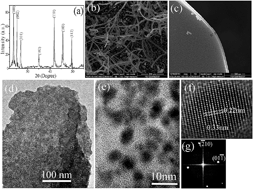Carbon-encapsulated CdSe quantum dot inorganic hybrid nanobelts for high performance photoelectronic devices based on the efficient separation and transfer of photoinduced holes
Abstract
We developed a facile method of combustion synthesis followed by a selenylation process to synthesize carbon-encapsulated CdSe hybrid nanobelts. In the nanohybrids, hexagonal-wurtzite-structured CdSe quantum dots (QDs) are formed in situ and embedded uniformly in the carbon nanobelt (CNB) matrix, resulting in the formation of an analogous p–i–n junction along the radius of the QDs due to the appearance of an inversion layer on the QD surfaces, which favors the separation of photoexcited electron–hole pairs by built-in electric field. Electrons accumulate in the QD core, while holes migrate to the QD surface and then quickly transfer to the CNB matrix. Additionally, the nanohybrids can enhance significantly the absorption of the whole energy range of visible light. The nanohybrids can show p-type conductivity with hole mobility as high as 1.4 × 104 cm2 V−1 s−1, and, furthermore, the single nanohybrid-based devices not only show excellent photodetection performance at a certain bias, but also show photovoltaic-based self-powered photodetection performance at zero bias upon illuminating one end electrode of the devices, pointing a way to the development of novel photoelectronic materials and devices for energy applications.

- This article is part of the themed collection: 2015 Journal of Materials Chemistry C Hot Papers

 Please wait while we load your content...
Please wait while we load your content...